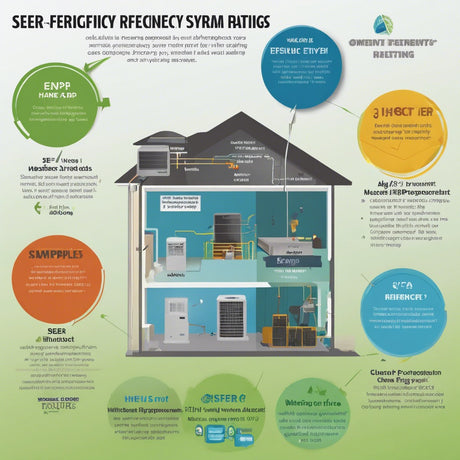- No products in the cart.
Understanding HVAC Efficiency Ratings: SEER, EER, and HSPF
06
Mar
Introduction: Heating, ventilation, and air conditioning (HVAC) systems are integral components of modern homes and buildings, providing comfort by regulating indoor temperature and air quality. However, as energy efficiency becomes a growing concern, understanding the efficiency ratings of HVAC systems becomes increasingly important. Three key metrics used to measure the efficiency of HVAC systems are SEER (Seasonal Energy Efficiency Ratio), EER (Energy Efficiency Ratio), and HSPF (Heating Seasonal Performance Factor). In this article, we delve into what these ratings mean and why they matter.
SEER (Seasonal Energy Efficiency Ratio): SEER is a measure of the cooling efficiency of an air conditioning system over an entire cooling season. It represents the ratio of the total cooling output (measured in BTUs) provided by the unit to the total electrical energy input (measured in watt-hours) over the same period. The higher the SEER rating, the more efficient the system is at cooling. In the United States, the minimum SEER rating for new residential air conditioners is 14, but more efficient models can have SEER ratings of 20 or higher. Upgrading to a higher SEER-rated system can lead to significant energy savings and reduced utility bills over time.
EER (Energy Efficiency Ratio): EER is similar to SEER but measures the efficiency of an air conditioning system at a specific outdoor temperature (usually 95°F or 35°C). Unlike SEER, which considers varying outdoor temperatures throughout the cooling season, EER provides a snapshot of the system's efficiency under specific conditions. While SEER is more commonly used for residential systems, EER is often utilized for commercial applications where constant cooling loads are expected. Like SEER, a higher EER rating indicates greater energy efficiency.
HSPF (Heating Seasonal Performance Factor): HSPF is a measure of the heating efficiency of a heat pump over an entire heating season. It represents the ratio of the total heating output (measured in BTUs) provided by the unit to the total electrical energy input (measured in watt-hours) over the same period. Heat pumps are popular for both heating and cooling because they can extract heat from the air or ground to warm indoor spaces during winter months. Similar to SEER for cooling, a higher HSPF rating signifies greater efficiency for heating. In colder climates, where heating demands are higher, choosing a heat pump with a higher HSPF can result in significant energy savings.
Why Efficiency Ratings Matter: Understanding and paying attention to SEER, EER, and HSPF ratings is crucial for several reasons:
- Energy Savings: Higher efficiency ratings mean lower energy consumption, leading to reduced utility bills and long-term cost savings.
- Environmental Impact: More efficient HVAC systems consume less energy, resulting in reduced greenhouse gas emissions and environmental footprint.
- Comfort: Efficient HVAC systems can maintain more consistent indoor temperatures, providing enhanced comfort and air quality.
- Regulatory Compliance: Building codes and regulations often mandate minimum efficiency standards for HVAC systems to promote energy conservation and sustainability.
Conclusion: Efficiency ratings such as SEER, EER, and HSPF are valuable tools for evaluating the performance and energy efficiency of HVAC systems. By understanding these ratings and their significance, consumers can make informed decisions when selecting heating and cooling solutions for their homes or buildings. Investing in higher-rated systems not only saves money and reduces environmental impact but also ensures greater comfort and satisfaction in the long run.













